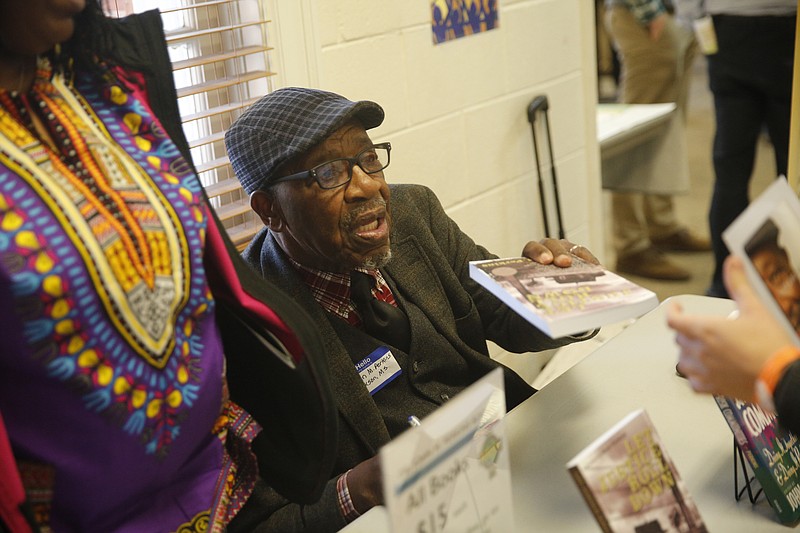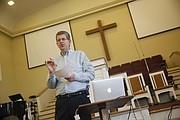Around noon on Saturday the head of the local United Way, Lesley Scearce, called Ternae Jordan, local pastor and community activist, to stand center stage with her in front of hundreds gathered at New City Fellowship, one of the few mixed-race churches in Chattanooga.
It was a climactic moment in a weekend full of sudden realizations, according to many who attended the two-day workshop called Faith, Work & the Church, sponsored by the United Way, the Chalmers Center at Covenant College and the nonprofit Hope for the Inner City. More than 250 people signed up to attend, and organizers estimated 75 percent were from the Chattanooga area.
Pretend you are in elementary school, Scearce told Jordan.
To their right and left, people got up from their seats and formed lines.
Imagine what you were up against, Scearce said. Jordan nodded his head, explaining to the crowd that he had grown up amidst poverty and struggle.
Then Scearce waved for the line on the right side of the sanctuary to move forward.
Single file, each person stood in front of Jordan and explained why a school-age child in inner-city Chattanooga could never succeed, underscoring why those who experience poverty and the trauma it imparts struggle to move up the income ladder.
That sobering reality was balanced, however, by the line of people waiting to the left of the stage.
"What are you?" Scearce asked, with the enthusiasm of a kindergarten teacher.
"Community assets," the first woman in line responded.
And fairly quickly Scearce's message became clear.
Thousands of families with young children in Chattanooga face insurmountable odds. And without a community intervention, without the love preached by Jesus, without renewed trust, neighbor to neighbor, local data show all of our futures become precarious, Scearce warned.
When the group broke for lunch and talked about ways churches could join together in action, Jordan reflected on the lesson.
"If we are on a ship and there is a hole in the south side of the ship, the rest on the ship don't continue to sunbathe and enjoy the voyage," Jordan said. "We know that when we go down, we all go down together."
This spring the Times Free Press' eight-part series, "The Poverty Puzzle," explored solutions to the growing threat of poverty, social isolation and other limits to economic mobility that impede opportunities for local children.
One study, published by Harvard University, cited in the series showed growing up in Hamilton County hurts poor and middle-class children's chances of finding spouses and earning a living wage more than it helps.
The same study, using tax records to map U.S. economic mobility, showed that almost the entire nation - 91 percent of counties - did a better job of creating paths to high earnings for children born at the bottom than did Hamilton County.
The Times Free Press series collected a massive amount of local, state, regional and national data on poverty and economic mobility. That data is all online at www.timesfreepress.com/povertypuzzle.
Before and since then, Eileen Rehberg, United Way's director of community impact, data analysis and strategy, has been working with sophisticated mapping software to add another layer to the community's understanding.
For the weekend workshop she studied the community's neediest pockets and created multilayered maps that showed churches where they were in proximity to their neighborhood's needs, as well as where they were in proximity to other churches and community resources.
Rehberg said the idea was to help local churches find ways to work together to meet growing needs in places such as East Ridge and Highland Park.
After the Superior Creek Lodge extended-stay hotel in East Ridge was shut down last fall, triggering a local homelessness crisis, several churches that had helped respond decided to continue working together in that community, where calls to United Way's 211 hotline are skyrocketing. Watching the congregations learn, grow and work together inspired Rehberg to think of ways others could unite in hyper-local efforts that wrap around struggling families.
Those facts were some of the most alarming takeaways Saturday, said Heather Herweyer, 33, who works at Northside Neighborhood House and attends New City East Lake.
"When I looked at the stats presented by Eileen, it's really depressing," Herweyer said. "Living there, it can begin to feel normal to me, but looking at the reading level of kids, it's not just those kids over there, it's those kids that live two doors down from me.
"It can't be just about programs," she added. "They need relationships. They need people at 7 a.m. sometimes and 11 p.m. sometimes. Sometimes they need a ride to school. I chose to live in a low-income area, but I realize that I am still disconnected. Connecting with someone from another class is challenging. How can we relate? How can we find common ground? I have to work at it."
The whole community - slowly waking up to the fact that Chattanooga's downtown renaissance and population boom has masked spreading economic desperation among all races - has a lot of work to do, said Scearce, who spoke of what she called a local "crisis of connectedness" that was sowing economic as well as social and spiritual poverty.
But, she asked, what if local neighborhoods began to feel like communities?
What if Highland Park embraced its status as one of the most diverse ZIP Codes in the county and fought to remain so? What if the 10 associations in the neighborhood, the 20 child care providers, the 29 churches and all the other community-based service providers knew one another, worked together and took stock of their community's strengths and weaknesses?
A lot of churches have mercy ministries or give food vouchers to the needy, but Scearce stressed that struggling families in Chattanooga need to be woven into the fabric of our everyday lives, not given a handout and sent on their way.
"What can churches do? Deal with issues around poverty, literacy and unemployment," Scearce pleaded.
Afterward, Wendi Schroyer, a member at Rivermont Presbyterian Church who led a discussion session Saturday, said she was prepared to act, with pages of information to bring back to her church. Some of the facts may require the church members to rethink the ways they have done things in the past, she said.
The topic of poverty has become toxic in modern America, she said, but Christians, called by the Bible to love, and especially to love the unlovely, shouldn't be controlled by fear.
"We need to partner with more churches," she said. "It's not about writing a check, it's about having a relationship."
Contact staff writer Joan McClane at jmcclane@timesfreepress.com or 423-757-6601.


